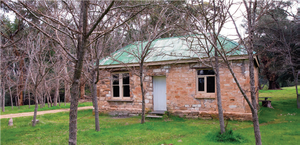By Christine Adams, Graduate Diploma in Archaeology and Cultural Heritage Management student
This is my final post on the Wirrabara and Bundaleer Forests. During this directed study I have worked with Kylie Lower of Blackwood Heritage Consulting. I have learnt about the Nukunu community and the Wirrabara and Bundaleer Forests, both of which I knew very little about before this project. One of the project highlights was meeting members of the Nukunu community. Although, I did not visit Wirrabara and Bundaleer Forests, through visiting Port Augusta I witnessed the Nukunu connection to Country and their culture. This experience, as well as the oral history interview and documentary sources, indicates their ongoing connection to Wirrabara and Bundaleer Forests. Due to the presence of European sites, these forests are also likely to be significant to the descendants of European settlers and other members of the local community.
This project has also refreshed my memory of ArcGIS software. Regarding the research, it has surprised me that some information was relatively easy to find and yet some was very difficult to locate or couldn’t be found at all. I recently managed to find Lothar Brasse Architects’ conservation report, which provided further insights into the history of the forests and sites within the study area, and for environmental and geological information, Laut et al. 1977 was very useful. Also, a couple of PhD theses have been helpful for my research: Husmann 2004 and Krichauff 2014. It would be useful for future researchers to contact the South Australian Museum regarding relevant collections that they hold and to conduct archaeological surveys in the forests. The project has been very demanding but a worthwhile experience.
References
Husmann, J. 2004 Transplantations: a Comparative History of Afforestation in Nebraska and South Australia 1870s- 1940s. Unpublished history PhD thesis, Faculty of the Graduate College, The University of Nebraska, Lincoln.
Krichauff, S. 2014 ‘Looking Back There was a Lot we Missed’: an Examination of how Settler Descendants from South Australia’s North-East Highland and Wirrabara Districts Know and Understand the Nineteenth-century Colonial Past. Unpublished PhD thesis, Faculty of Health, Arts and Design, Swinburne University of Technology, Melbourne.
Laut, P., P.C Heyligers, G. Keig, E Loffler, C Margules, R.M Scott and M.E. Sullivan 1977 Vol. 5 Environments of South Australia Province 5 Eastern Pastoral and Province 6 Flinders Ranges. Report for division of Land Use Research Commonwealth Scientific and Industrial Research organization Canberra, Australia.
Lothar Brasse Architects 2000 Bundaleer and Wirrabara Forest Reserves Conservation Plan. Unpublished report prepared for Forestry SA.


